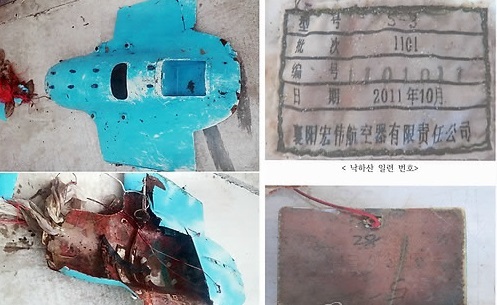An unmanned aerial vehicle presumed to have come from North Korea violated the border Wednesday, prompting the South Korean military to fire warning shots and scramble fighter jets, officials said.
The drone emerged at around 2:10 p.m. near the Dorasan observation post in Paju, Gyeonggi Province, and turned back immediately after the South issued warnings and then fired some 20 rounds from a K-3 machine gun.
“An unidentified small flight vehicle, which was spotted by our radar flying in the North skies in the morning, approached the Military Demarcation Line and then invaded it by dozens of meters for several seconds,” an official at the Joint Chiefs of Staff told reporters on the customary condition of anonymity.
 |
| Remains of a drone believed to be the same model owned by North Korea found near Baengnyeongdo Island in September 2014 are seen. Yonhap |
The drone, the first detected since the two Koreas’ high-level dialogue late last August, is likely to have been dispatched to track the movement of frontline South Korean units following Seoul’s restart last Friday of propaganda loudspeaker broadcasts throughout the Demilitarized Zone.
In another apparent tit-for-tat move, Pyongyang has started distributing anti-Seoul propaganda leaflets across the frontier.
Some of the leaflets were discovered in parts of Seoul and Goyang, Paju and other northern locales in Gyeonggi Province early in the morning. The papers mainly called for an end to the border broadcasts and “knockdown” of the Park Geun-hye government.
The South’s military said it detected the North’s launch of plastic balloons believed to be carrying the fliers late Tuesday and early Wednesday, warning of a resumption of its own pamphlet-spraying activities.
“We’ve yet to decide, but are ready to undertake our leaflet operations, closely monitoring the North Korean military’s movement,” the JCS official said.
The communist state has previously sent anti-Seoul brochures mostly toward border islands in the West Sea, but the latest scattering is deemed unusual, given its vast scale traversing the Seoul metropolitan area.
The two rare events, coupled with Pyongyang’s reactivation of its own loudspeakers, are stoking concerns that it may soon stage a bigger provocation, such as in the frontline regions.
Shortly after the South resumed the broadcasts last August in retaliation against the North’s land mine attack, it fired artillery shells near a loudspeaker erected in a western border town, declaring a “quasi-state of war,” forward-stationing offensive assets and placing troops in full combat readiness.
The JCS released four different fliers, each measuring 12 centimeters by 4.5 centimeters and printed on white and violet laminated paper.
“As we do with a rabid dog, let’s crack the Park Geun-hye clique that deteriorated the North-South relations by resuming anti-North psychological warfare broadcasts,” reads one, while another says, “Stop immediately the anti-North psychological warfare broadcasts that would light the fuse of a war.” Others warn Seoul against jeopardizing its own safety through a provocation, and urge the U.S. to scrap what it calls an “anti-North hostile policy.”
The police also collected some 1,000 handouts near Seoul Forest that threatened a “bombardment of fire” for offending the Kim Jong-un leadership, and more from Uijeongbu, Dongducheon, Paju, Yangpyeong and other Gyeonggi Province areas.
“The North spread them apparently to help offset the effects of our broadcasts,” a Defense Ministry official said.
The South Korean military’s leaflet operations have been on hold since the two Koreas agreed to cease propaganda activities in June 2004, though some defectors and nongovernmental organizations have been allowed to carry out their own campaigns.
Earlier in the day, seven members of the defector group Fighters For Free North Korea, led by Park Sang-hak, sought to launch about 300,000 anti-Pyongyang fliers in Gimpo, Gyeonggi Province. But the police blocked their advancement, citing concerns over residents’ safety.
By Shin Hyon-hee (heeshin@heraldcorp.com)

